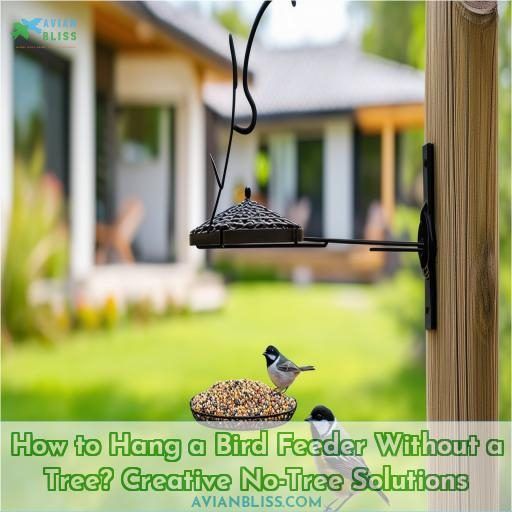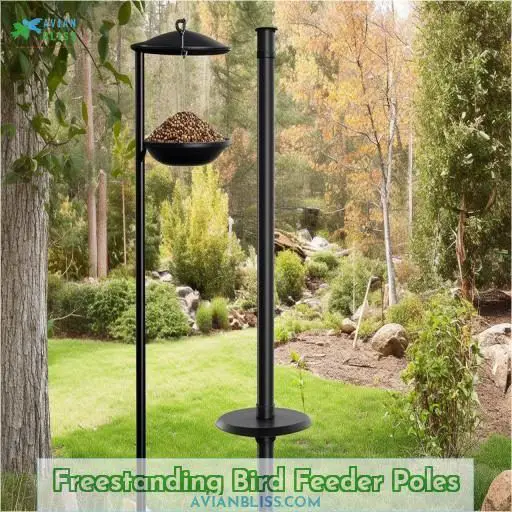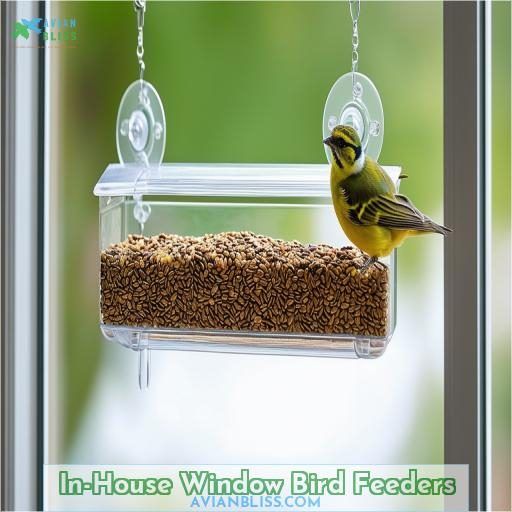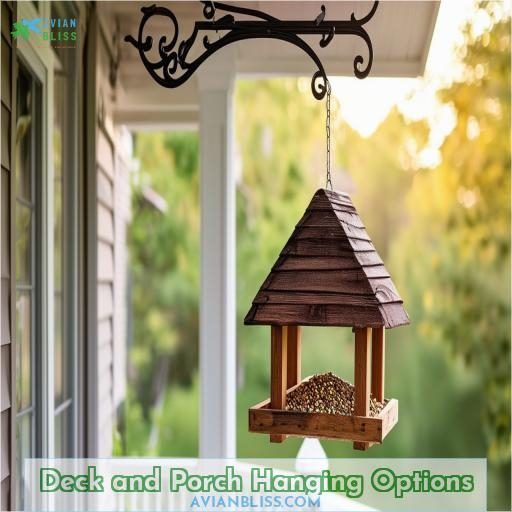This site is supported by our readers. We may earn a commission, at no cost to you, if you purchase through links.

For a space-saving solution, wall-mounted feeders securely attach to your home’s exterior using brackets or suction cups. If you’d prefer up-close views, consider an in-house window feeder – just make sure it’s pet-friendly.
Get creative by hanging feeders from eaves, ceilings of covered outdoor spaces, or even utilize suction-cup window mounts. With some ingenuity, you’ll discover the perfect no-tree solution to delight your local avian visitors.
Table Of Contents
- Key Takeaways
- How to Hang a Bird Feeder Without a Tree?
- Choosing the Right Location for Your Bird Feeder
- Freestanding Bird Feeder Poles
- Wall-Mounted Bird Feeders
- In-House Window Bird Feeders
- Deck and Porch Hanging Options
- Other Creative Hanging Methods
- Frequently Asked Questions (FAQs)
- Where should you not hang a bird feeder?
- What can I use to hang a bird feeder?
- Where is the best place to hang bird feeders?
- How to make bird feeder hangers?
- Can I use a chain instead of rope to hang a bird feeder?
- How do I attach a bird feeder pole to my deck railing?
- What knots work best for hanging a bird feeder?
- Will a window feeder attract more birds in winter?
- How can I make a brush pile to attract birds?
- Conclusion
Key Takeaways
- Think outside the box and get creative! From poles and wall-mounted brackets to suction cups and ceiling hooks, you’ve got a buffet of options to whip up a stylish bird café without relying on trees.
- Safety first, my feathered friends! When hanging your feeder, make sure it’s securely mounted and keeps pesky predators like sneaky squirrels and curious cats at bay. After all, we want our avian visitors to dine in peace, right?
- Go the extra mile with pest-proof feeders featuring built-in deterrents like spin-off perches or weight-sensitive tilting mechanisms. Those squirrels may be persistent, but we’re one step ahead in this feathery feud!
- Don’t be a stranger to nature’s quirky characters! While hanging your feeder, get inspired by the great outdoors. Repurpose fallen branches or twigs as rustic hangers, or craft a cozy brush pile for your newfound feathered friends to nest and roost.
How to Hang a Bird Feeder Without a Tree?
To hang a bird feeder without a tree, you can use freestanding poles, wall-mounted feeders, window feeders, or hang them from eaves, ceilings, or decks using hooks or suction cups (Source). Choose an open area with good visibility for birds and make sure the location is safe from predators .
Choosing the Right Location for Your Bird Feeder
When selecting a location for your bird feeder, opt for an open area that offers good visibility for birds to easily spot the feeder. Simultaneously, make certain the chosen spot is safe from potential predators, such as neighborhood cats or hawks, and inaccessible to pets that may disturb the feeding area.
Select an Open Area With Good Visibility for Birds
To attract birds, choose an open area with good visibility. Avoid obstacles like buildings or dense foliage that could block the feeder. Place it at eye level or slightly above for best viewing. Consider the feeder’s proximity to your home for easy refilling and cleaning. Make sure it’s protected from harsh weather conditions that could damage the feeder or food.
Ensure the Location is Safe From Predators and Pets
To make certain your feeder is protected from predators and pets, position it at least 10 feet away from windows, trees, and other structures that could provide entry points. Opt for a window feeder or wall-mounted option for close observation while deterring unwanted visitors. Avoid placing feeders near busy areas or where pets roam to create a secure environment for your feathered friends.
- Position feeders at least 10 feet from windows, trees, and structures
- Choose window, wall-mounted, or suction-cup feeders for safer placement
- Avoid busy areas and pet-friendly zones for optimal bird safety
- Hang ceiling feeders in covered outdoor spaces for protection
- Consider the environment when selecting a feeder location
Freestanding Bird Feeder Poles
Freestanding bird feeder poles provide an easy-to-install and movable solution for hanging feeders without a tree. Carefully review weight capacity instructions and consider incorporating features like baffles or cones to deter pests from accessing the feeder.
Easy to Install and Move as Needed
Freestanding bird feeder poles are a versatile solution, offering easy installation and mobility. Their height adjustability guarantees adequate bird visibility, while weather-resistant materials enhance durability. Pest control features can be incorporated to keep feeders secure from squirrels. These poles blend aesthetics with functionality, making them a practical choice for your yard or garden, requiring minimum effort for repositioning (Source).
Check Weight Capacity Instructions
When installing freestanding bird feeder poles, always check the weight capacity to guarantee your feeder doesn’t come crashing down. Look for poles that can handle the weight of your chosen feeder, plus any extras like squirrel baffles. With the right pole, you can easily relocate your feeder as needed, creating a dynamic bird-watching experience in your yard.
Incorporate Pest Deterrence Features
To deter pesky pests like squirrels, look for freestanding poles with built-in pest deterrents.
Opt for poles with weight-sensitive perches that trigger a spin or tilt, safely displacing squirrels.
Make certain the pole is sturdy and the feeder hangs securely to prevent tipping.
Choose feeders with weight-bearing capacity and durable construction to withstand squirrel antics.
Prioritize bird safety and feeder durability when selecting pest control features for your freestanding pole.
Wall-Mounted Bird Feeders
Wall-mounted bird feeders offer a convenient and space-saving solution for attracting feathered friends without relying on trees.
These feeders can be securely attached to walls using various methods, such as direct nailing, hooks, or even damage-free options like Command Hooks.
Look for models with rain-resistant tops to protect the seed from the elements. Some wall-mounted feeders even feature perch designs that deter squirrels and other unwanted guests.
When selecting a wall-mounted feeder, consider the material (metal vs. plastic) and the type of seed it can accommodate.
With proper installation and weatherproofing techniques, a wall-mounted bird feeder can provide endless hours of birdwatching enjoyment right from your own backyard.
In-House Window Bird Feeders
In-house window bird feeders provide an excellent opportunity for close observation of avian visitors, thanks to their strategic placement adjacent to windows. However, these feeders may not be suitable for households with pets, as the proximity could potentially lead to unwanted interactions or disturbances.
Provide Close Observation of Birds
In-house window bird feeders allow you to observe birds up close, providing an intimate view of their behavior and interactions. Choose a feeder designed for windows, with suction cups or brackets for secure mounting. Position it near your favorite chair or workspace for easy viewing. Fill with high-quality seed to attract a variety of species right to your window.
Feature Removable Caps for Easy Refilling
In-house window feeders provide close bird observation and feature removable caps for easy refilling. These feeders are:
- Convenient to refill without disturbing birds.
- Cost-effective, reducing birdseed waste.
- Durable, designed to withstand frequent use.
- Aesthetically appealing, blending with your window design.
- Functional, ensuring the feeder stays clean and hygienic.
May Not Be Suitable for Homes With Pets
While in-house window bird feeders offer close observation of your feathered friends, they may not be the best choice if you have curious pets at home. To guarantee the safety of both birds and pets, consider placement in a room with limited pet access and regularly clean the feeder to prevent pest infestations. Prioritize bird safety when selecting a window feeder location.
| Pets | Bird Safety | Feeder Placement | Pest Control | Cleaning |
|---|---|---|---|---|
| Curious cats and dogs can startle birds | Make sure feeders are securely mounted | Choose a room with limited pet access | Clean feeders regularly to prevent infestations | Maintain hygiene to keep birds safe |
| Pets may damage or knock down feeders | Use feeders designed for window mounting | Place feeders at eye level for easy viewing | Use pest-resistant feeders and food | Clean frequently to prevent mold and bacteria |
| Pets can scare birds away from feeders | Prioritize bird safety over pet access | Avoid placing feeders near pet resting areas | Incorporate pest deterrents into feeder design | Clean thoroughly to maintain bird health |
| Pets may try to catch birds at the feeder | Make sure feeders are stable and secure | Place feeders in a quiet, low-traffic area | Use feeders with pest-proof features | Clean regularly to prevent disease transmission |
| Pets can disrupt bird feeding and nesting | Use feeders designed to withstand pet interactions | Place feeders in a location with good visibility | Regularly inspect feeders for pest infestations | Clean and maintain feeders to guarantee bird safety |
Deck and Porch Hanging Options
When hanging bird feeders from decks or porches, you must carefully consider the weight capacity of the hanging apparatus and make sure it can reliably support the feeder, especially when filled with seed. Additionally, incorporating suet cages can help minimize mess by containing the crumbly suet residue that may otherwise accumulate on the deck or porch surface.
Consider Weight Capacity and Reach for Refilling
When using deck or porch hangers for your bird feeder, guarantee stability and safety by checking the weight capacity to avoid accidents. Position the feeder where it’s easily accessible for refilling. Proper pole placement ensures even weight distribution, enhancing bird safety. Incorporate pest control measures to protect the feed from unwanted visitors while maintaining a pleasant viewing experience.
Use Suet Cages to Minimize Mess
When hanging bird feeders on your deck or porch, consider using suet cages to minimize mess.
Suet cages are ideal for offering high-energy suet treats that birds love, while containing any crumbs or droppings.
Place suet cages near your main seed feeders for convenience.
Clean suet cages regularly to prevent mold and guarantee birds’ safety.
Suet cages are a great alternative to messy loose suet.
Other Creative Hanging Methods
For other creative hanging methods, consider utilizing the eaves of your home with ceiling hooks or magnetic hooks to suspend bird feeders. Additionally, explore the option of suction-cup window feeders, which can provide an up-close view of visiting birds, or hang feeders from ceilings in covered outdoor spaces like patios or porches.
Utilize Eaves With Ceiling Hooks or Magnetic Hooks
Utilize the eaves of your home by hanging bird feeders from ceiling hooks or magnetic hooks.
Position the hooks strategically to provide adequate feeder visibility and accessibility for birds.
Consider the magnetic strength necessary to securely hold the feeder in place.
Make sure the hook placement doesn’t interfere with the eaves’ protective function.
Adjust the hanging height as needed for best results.
Explore Suction-cup Window Feeders
Shifting from eaves to windows, suction-cup bird feeders grant close observations and sleek aesthetics. They establish security and cleaning ease with strong suction, clear visibility, and bird-friendly design. Follow these steps:
- Clean the window surface thoroughly.
- Attach the feeder using sturdy suction cups.
- Fill with suitable bird feed.
- Monitor and clean regularly to maintain allure and safety.
Hang Feeders From Ceilings in Covered Outdoor Spaces
For elevated birdwatching, hang feeders from ceilings in covered outdoor spaces using repurposed materials like chains or rope. Guarantee invisible suspension for a clean look, considering weight restrictions. Adjust seasonally to accommodate changing feeder sizes. This creative approach allows you to enjoy birds up close while protecting them from weather and predators (Source).
Frequently Asked Questions (FAQs)
Where should you not hang a bird feeder?
Avoid hanging bird feeders near windows, patios, or high-traffic areas where birds may feel exposed to predators, pets, or human disturbances. Always prioritize their safety and comfort.
What can I use to hang a bird feeder?
Let’s explore some creative feeder hanging spots, shall we? You can utilize sturdy poles, brackets, hooks, suction cups, or even suspend them from eaves and ceilings with ropes or chains to accommodate your feathered friends.
Where is the best place to hang bird feeders?
You’ll want to place bird feeders in open areas with good visibility, near trees or shrubs for cover. Consider hanging them from eaves, decks, or poles for accessibility. The key is keeping them safe from predators and easy to maintain.
How to make bird feeder hangers?
Express your creativity, you craftsperson! Repurpose items like pipes, chains, or logs to fashion sturdy, eye-catching hangers for your feathered friends’ gourmet station.
Can I use a chain instead of rope to hang a bird feeder?
Yes, you can absolutely use a chain instead of rope to hang a bird feeder. Chains are sturdy, durable, and won’t stretch or fray over time like rope can. Just be sure to get a chain with the appropriate weight capacity for your feeder.
How do I attach a bird feeder pole to my deck railing?
To attach a bird feeder pole to your deck railing, you’ll need either a secure clamping mechanism or mounting brackets designed for railings. Follow the manufacturer’s instructions and make sure a stable, level installation.
What knots work best for hanging a bird feeder?
The bowline knot, a tried-and-true seafarer’s favorite, crafts a loop that won’t slip or jam, making it an ace choice for securely suspending bird feeders.
Will a window feeder attract more birds in winter?
Yes, window feeders attract more birds in winter. During the cold months, birds need extra sustenance, making your feeder an enticing food source visible from their sheltered hideouts. Just make certain it’s well-stocked and accessible for maximum avian visitors!
How can I make a brush pile to attract birds?
Want a thriving backyard ecosystem? Build a brush pile! They provide cozy nooks for birds to nest, roost, and find food like insects and seeds. Simply gather fallen branches, twigs, and leaves – nature’s ingredients for an avian paradise.
Conclusion
Like an artist applying brushstrokes to canvas, you can hang a bird feeder without a tree by creatively exploring various mounting options.
Whether utilizing freestanding poles, wall-mounted brackets, window suction cups, or creative ceiling hooks, you’ll attract feathered friends with proper positioning and pest deterrence.
Through ingenuity, you’ll discover the perfect no-tree solution to delight your local avian visitors while providing an open area with good visibility.








